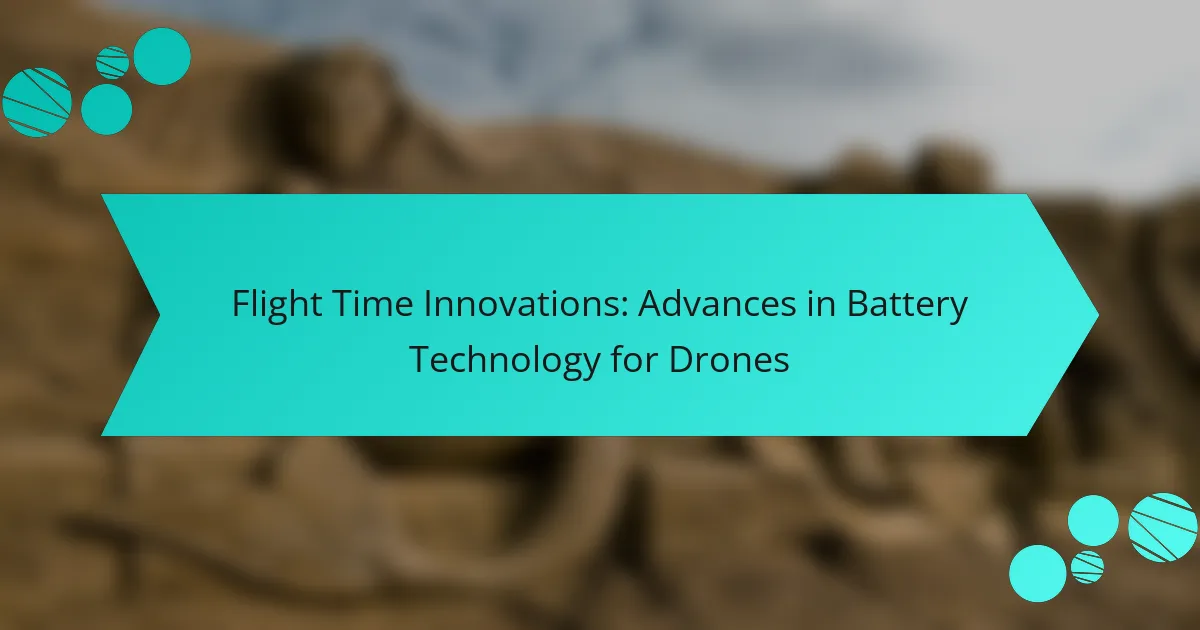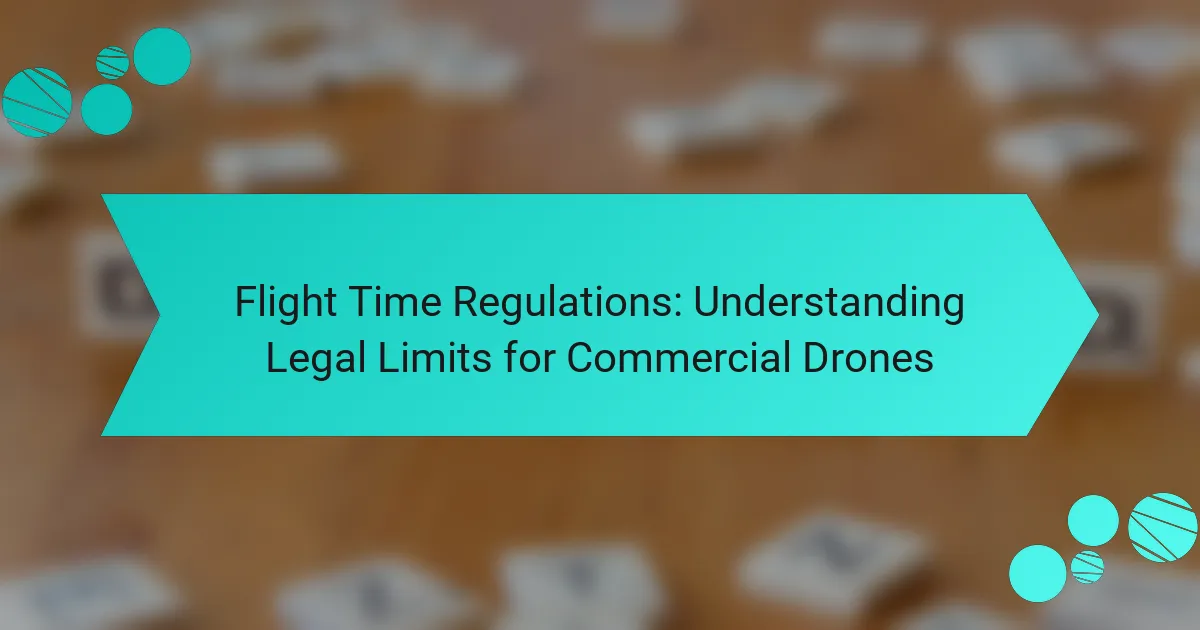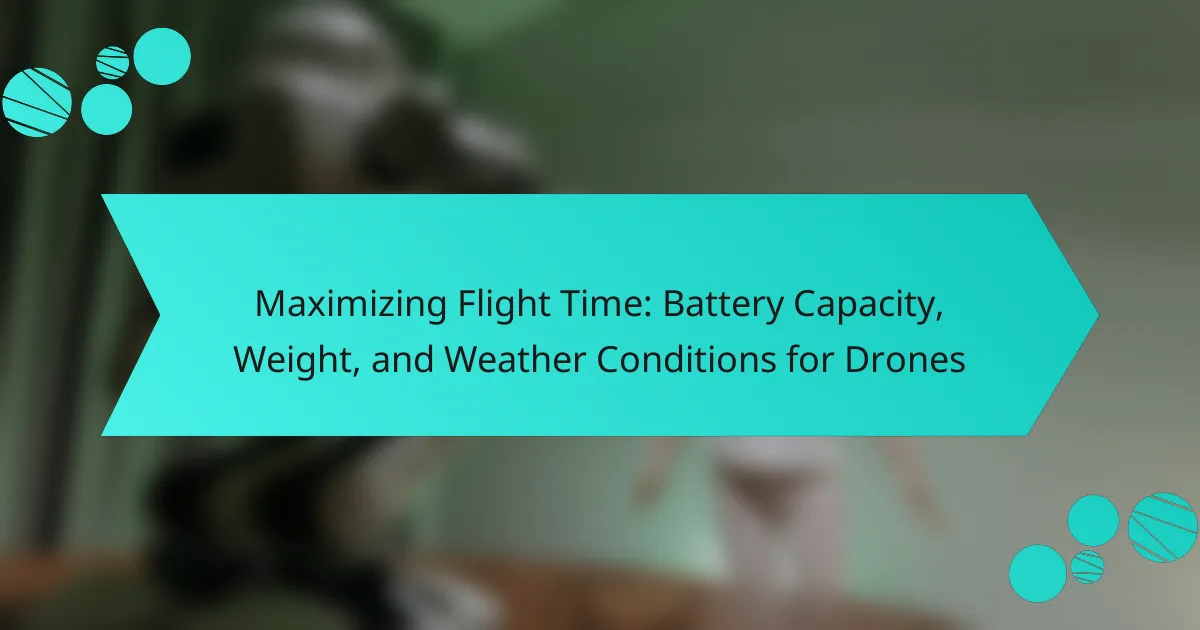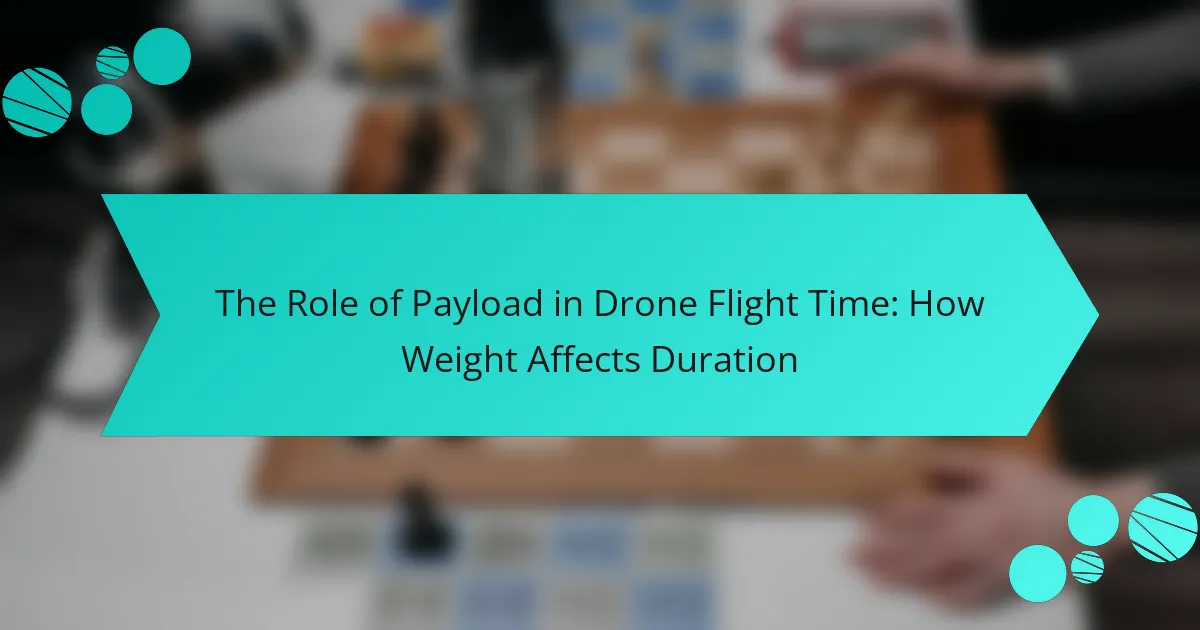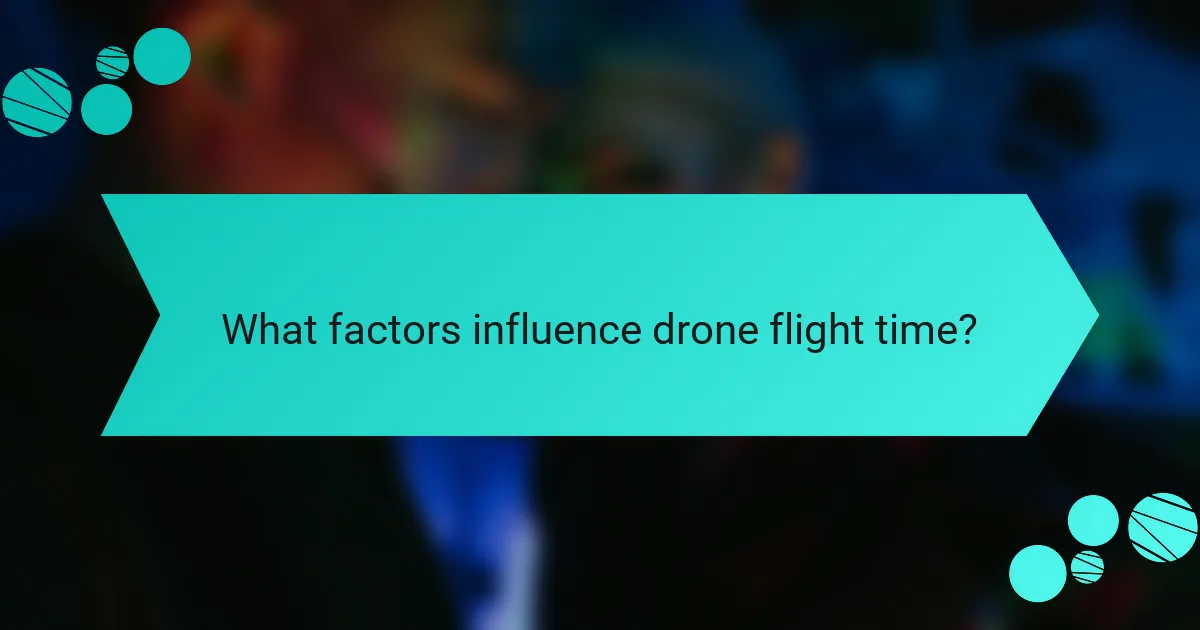
What factors influence drone flight time?
Drone flight time is influenced by several key factors. Battery capacity is a primary determinant. Higher capacity batteries provide longer flight durations. Weight of the drone also plays a critical role. Heavier drones require more power, reducing flight time. Aerodynamics impacts how efficiently a drone moves through the air. Better aerodynamics lead to less energy consumption and extended flight times. Weather conditions can affect performance as well. Wind resistance can shorten flight duration significantly. The type of propulsion system used also matters. More efficient motors can enhance flight time. Lastly, flight style and usage patterns influence how long a drone can stay airborne. Aggressive maneuvers consume more battery power compared to stable flight.
How do battery specifications affect flight duration?
Battery specifications significantly affect flight duration. Higher capacity batteries store more energy, allowing for longer flight times. For example, a 5000 mAh battery can provide approximately 25 minutes of flight, while a 3000 mAh battery may only last around 15 minutes. Voltage also plays a critical role; higher voltage can improve motor efficiency and overall performance. Additionally, battery weight impacts flight duration; heavier batteries reduce the drone’s efficiency and can shorten flight time. The discharge rate, measured in C ratings, determines how quickly a battery can release energy. A battery with a higher C rating can maintain power under heavy load, enhancing flight stability and duration. Therefore, selecting the right battery specifications is crucial for optimizing flight duration in drones.
What is the significance of battery capacity in drones?
Battery capacity in drones is crucial for determining flight time and operational efficiency. Higher capacity allows for longer flight durations, enabling drones to cover greater distances. For example, a drone with a 4500 mAh battery can fly significantly longer than one with a 2000 mAh battery. This capacity directly impacts the payload that a drone can carry, affecting its functionality. Additionally, battery capacity influences the frequency of charging cycles needed during operations. Efficient use of battery capacity can enhance mission effectiveness in tasks like surveying or delivery. Therefore, understanding battery capacity is essential for optimizing drone performance.
How does battery type impact overall efficiency?
Battery type significantly impacts overall efficiency by influencing energy density, discharge rates, and lifespan. Lithium-ion batteries, for instance, offer higher energy density compared to nickel-cadmium batteries. This means they can store more energy in a smaller size, resulting in longer flight times for drones.
Additionally, lithium-ion batteries have lower self-discharge rates, allowing drones to maintain charge longer when not in use. The discharge rate also affects how quickly energy is released during flight. High-discharge lithium batteries provide better performance for demanding applications, such as racing drones.
Moreover, battery lifespan varies by type. Lithium-ion batteries typically last longer than lead-acid batteries, reducing the need for frequent replacements. This longevity contributes to overall efficiency by minimizing downtime and maintenance costs.
In summary, the choice of battery type directly affects a drone’s flight time, performance, and operational costs.
What role does drone design play in flight time?
Drone design significantly impacts flight time. The aerodynamics of the drone’s shape influences how efficiently it moves through the air. A streamlined design reduces drag, allowing for longer flight durations. Battery placement within the drone affects its center of gravity, which can enhance stability and efficiency. The weight of materials used in construction also plays a crucial role; lighter materials generally lead to improved flight times. Additionally, the design of the propellers affects thrust and energy consumption. Efficient propeller design can optimize lift while minimizing battery drain. Overall, thoughtful drone design directly correlates with enhanced flight time and operational efficiency.
How do weight and aerodynamics influence flight duration?
Weight and aerodynamics significantly influence flight duration. Increased weight requires more energy for lift, reducing flight time. Heavier drones consume battery power faster, leading to shorter operational periods. Aerodynamics affects how efficiently a drone moves through the air. Improved aerodynamic design minimizes drag, allowing for longer flights. A streamlined shape reduces resistance, enhancing energy efficiency. Studies show that optimizing weight and aerodynamics can extend flight duration by up to 30%. Therefore, both factors are critical in determining how long a drone can fly effectively.
What design features can enhance efficiency?
Aerodynamic shape enhances efficiency in drone design. A streamlined body reduces drag during flight. Lightweight materials contribute to improved flight duration. Efficient propeller design increases thrust while minimizing energy consumption. Battery placement affects the drone’s center of gravity, optimizing stability and control. Advanced flight control systems enable precise navigation and energy management. These design features collectively enhance overall performance and extend flight time. Studies show that drones with optimized aerodynamics can achieve up to 30% longer flight times compared to less efficient models.
How do environmental conditions affect drone flight time?
Environmental conditions significantly impact drone flight time. Factors such as wind speed, temperature, and humidity directly influence battery efficiency and aerodynamics. High winds can increase drag, leading to higher energy consumption. Cold temperatures can reduce battery capacity, resulting in shorter flight durations. High humidity levels may affect electronic components, potentially reducing performance. Studies show that a 10 mph increase in wind speed can reduce flight time by up to 20%. Understanding these conditions helps optimize drone operation and enhance flight efficiency.
What impact does temperature have on battery performance?
Temperature significantly affects battery performance. High temperatures can lead to increased self-discharge rates. This results in reduced overall battery life. Low temperatures can decrease the chemical reactions within the battery. Consequently, this leads to lower capacity and performance. Research shows that lithium-ion batteries perform optimally between 20°C to 25°C. Outside this range, efficiency drops sharply. For instance, at 0°C, a battery may lose up to 20% of its capacity. Therefore, managing temperature is crucial for optimal battery performance in drones.
How do wind and weather conditions alter flight duration?
Wind and weather conditions significantly alter flight duration. Strong headwinds can increase flight time by slowing the drone’s forward speed. Conversely, tailwinds can decrease flight time by aiding the drone’s movement. Additionally, adverse weather such as rain or snow can lead to increased drag and reduced efficiency. Temperature also plays a role; colder air can affect battery performance and propulsion efficiency. Studies show that wind speeds exceeding 15 mph can result in a 20% increase in flight duration. These factors collectively impact the overall efficiency and planning of drone flights.
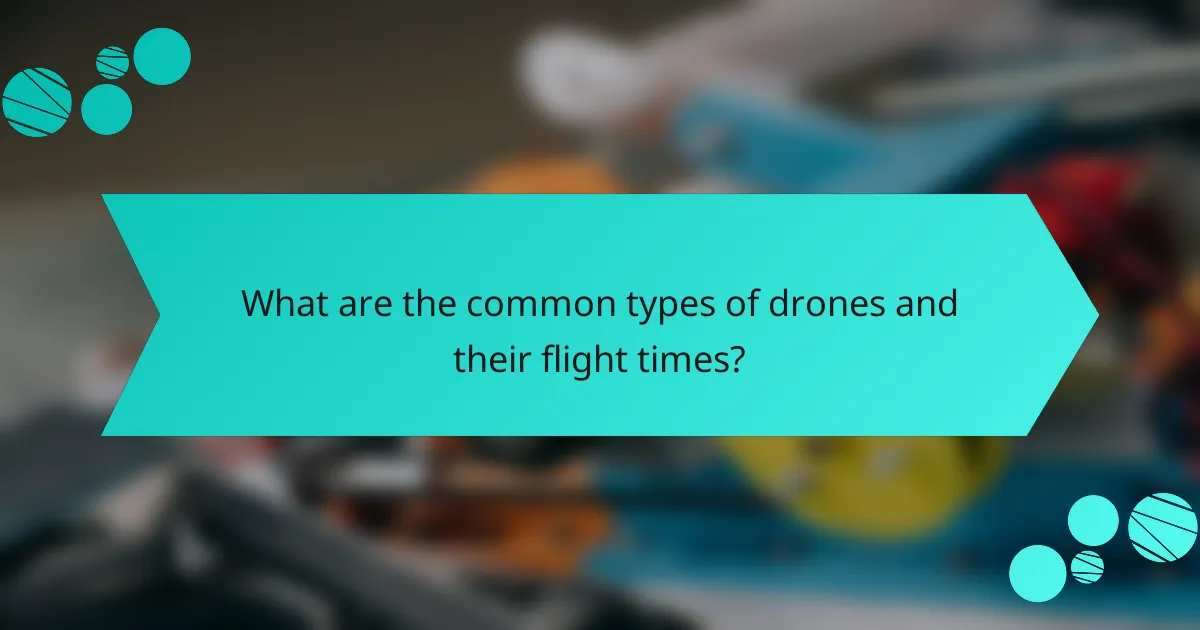
What are the common types of drones and their flight times?
The common types of drones include quadcopters, fixed-wing drones, and hybrid drones. Quadcopter drones typically have flight times ranging from 20 to 30 minutes. Fixed-wing drones can achieve longer flight times, often between 45 minutes to several hours, depending on their design and battery capacity. Hybrid drones combine features of both types and can have flight times similar to fixed-wing models, usually exceeding 30 minutes. Factors influencing these flight times include battery size, weight, and flying conditions.
How do consumer drones compare to professional drones in flight duration?
Consumer drones typically have shorter flight durations compared to professional drones. Consumer drones often achieve flight times of 20 to 30 minutes on average. In contrast, professional drones can sustain flights ranging from 30 minutes to over an hour. This difference is due to the larger battery capacities and advanced technology found in professional drones. For example, high-end models like the DJI Matrice series can fly for up to 40 minutes or more. Additionally, professional drones are designed for heavier payloads, which can also affect flight time. Overall, professional drones provide longer flight durations, making them more suitable for extensive aerial tasks.
What are the typical flight times for consumer drones?
Typical flight times for consumer drones range from 20 to 30 minutes. This duration is influenced by several factors. Battery capacity is a primary determinant of flight time. Most consumer drones have batteries ranging from 1000 mAh to 5000 mAh. Drones with larger batteries tend to achieve longer flight times. Additionally, weight and payload affect how long a drone can stay airborne. Heavier drones or those carrying additional equipment may experience reduced flight durations. Weather conditions also play a role, as wind and temperature can impact battery efficiency. Overall, users can expect flight times to vary based on these attributes.
How do professional drones achieve longer flight durations?
Professional drones achieve longer flight durations through advanced battery technology and efficient aerodynamics. High-capacity lithium polymer batteries provide more energy storage, allowing for extended flight times. Enhanced propulsion systems optimize energy consumption, increasing efficiency. Lightweight materials reduce overall drone weight, contributing to longer flights. Additionally, aerodynamic designs minimize drag, allowing drones to fly further on less power. Some models use energy-efficient motors that consume less electricity. Together, these factors enable professional drones to achieve flight durations exceeding 30 minutes, with some models reaching up to 60 minutes.
What are the specialized drones and their unique flight capabilities?
Specialized drones include agricultural drones, surveying drones, and delivery drones. Agricultural drones can perform crop monitoring and spraying with precision. They often feature multispectral sensors for assessing plant health. Surveying drones are designed for mapping and capturing high-resolution images. They utilize GPS technology for accurate positioning and data collection. Delivery drones can transport goods efficiently over short distances. Their flight capabilities include vertical takeoff and landing (VTOL) for navigating urban environments. Each type of specialized drone is engineered for specific tasks, enhancing operational efficiency and effectiveness.
How do racing drones differ in flight time from aerial photography drones?
Racing drones typically have shorter flight times compared to aerial photography drones. Racing drones are designed for speed and agility, often prioritizing performance over endurance. Their flight times generally range from 3 to 7 minutes, depending on battery capacity and flight conditions. In contrast, aerial photography drones are built for stability and longer durations. They can achieve flight times of 20 to 30 minutes or more, thanks to larger batteries and efficient designs. This difference in flight time is primarily due to the distinct purposes of each drone type. Racing drones require rapid power consumption for quick maneuvers, while aerial photography drones optimize energy use for extended flights.
What unique features do agricultural drones have that affect flight duration?
Agricultural drones have unique features that significantly affect flight duration. One key feature is battery capacity, which determines how long a drone can operate before needing a recharge. For example, high-capacity batteries can provide flight times exceeding 30 minutes.
Another feature is the weight of the payload. Heavier payloads reduce flight duration as they require more power to lift. Additionally, aerodynamic design plays a crucial role. Streamlined drones experience less drag, allowing for longer flights.
Flight control systems also influence duration. Advanced systems optimize power usage and flight paths, extending operational time. Furthermore, solar panels integrated into some models can recharge batteries during flight, enhancing duration.
These unique features collectively contribute to the efficiency and longevity of agricultural drones in the field.
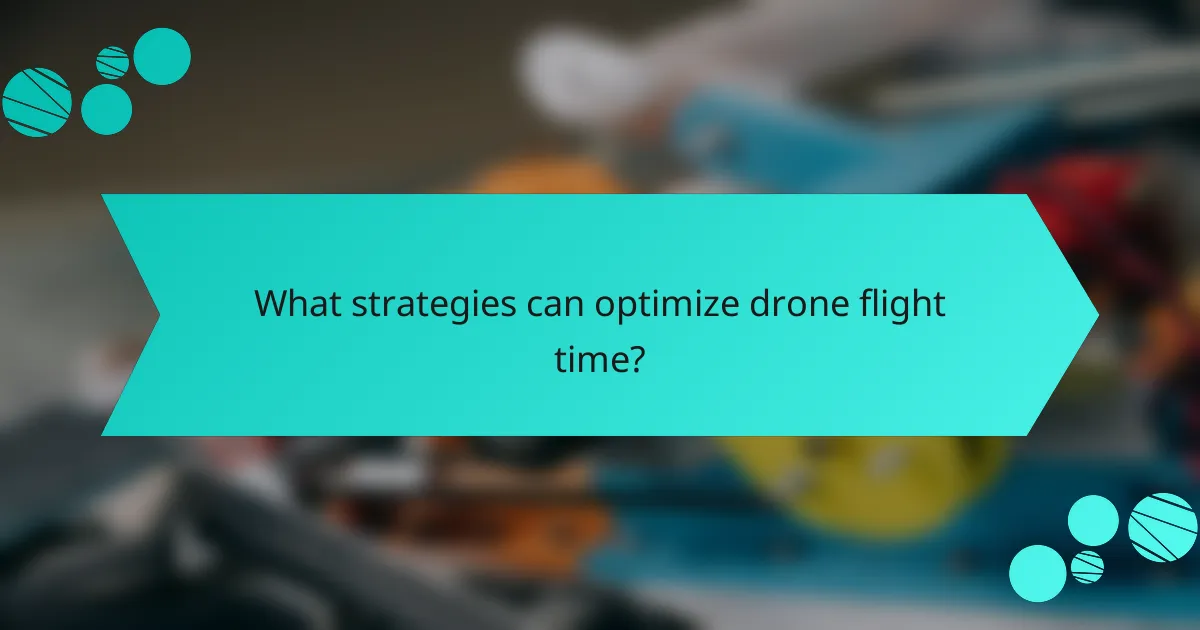
What strategies can optimize drone flight time?
To optimize drone flight time, several strategies can be implemented. First, weight reduction is crucial. Lighter drones consume less energy and can fly longer. Second, efficient battery management extends flight duration. Utilizing high-capacity batteries, such as lithium-polymer, can increase flight time significantly. Third, optimizing flight paths minimizes energy consumption. Direct routes and altitude adjustments can enhance efficiency. Fourth, regular maintenance ensures drones operate at peak performance. Well-maintained motors and propellers reduce energy loss. Fifth, using energy-efficient flight modes can conserve battery life. Many drones have settings for optimal energy use. Lastly, environmental factors such as wind resistance should be considered. Flying in calm conditions maximizes flight time. These strategies collectively contribute to enhanced drone flight efficiency.
How can pre-flight planning enhance flight efficiency?
Pre-flight planning enhances flight efficiency by optimizing route selection and minimizing fuel consumption. It allows operators to assess weather conditions and avoid turbulence, which can delay flights. Accurate weight calculations ensure that drones operate within optimal performance parameters. Planning also involves scheduling maintenance checks to prevent mechanical failures during flight. According to a study by the National Aeronautics and Space Administration (NASA), effective pre-flight planning can reduce flight time by up to 15%. This reduction directly correlates with improved overall efficiency and cost savings. By implementing detailed checklists, operators can ensure all equipment is functional, further enhancing safety and efficiency.
What are the best practices for route planning to maximize battery life?
The best practices for route planning to maximize battery life include optimizing flight paths, minimizing altitude changes, and avoiding obstacles. Efficient flight paths reduce travel distance and time, directly conserving battery power. Keeping a consistent altitude minimizes energy consumption associated with climbing and descending. Avoiding obstacles reduces the need for sudden maneuvers, which can drain battery life. Additionally, planning routes during favorable weather conditions can enhance battery performance. Wind resistance can significantly affect battery usage; thus, flying with the wind rather than against it is advisable. Lastly, regular monitoring of battery levels during flight helps in adjusting routes to ensure safe returns.
How does payload management affect flight time?
Payload management directly affects flight time by influencing the overall weight that a drone carries. Increased payload weight requires more energy for lift, resulting in higher power consumption. This higher energy demand reduces the battery life, leading to shorter flight times. Conversely, optimizing payload to match the drone’s capacity can enhance efficiency and prolong flight duration. Research indicates that exceeding recommended payload limits can decrease flight time by up to 30%. Proper payload management ensures that drones operate within their optimal performance range, maximizing flight efficiency.
What maintenance practices can prolong drone flight duration?
Regular battery maintenance can significantly prolong drone flight duration. Ensuring batteries are charged properly enhances their lifespan. Avoiding deep discharges can prevent battery damage. Cleaning battery contacts helps maintain a good connection. Regularly updating firmware optimizes drone performance. Checking propellers for damage improves efficiency. Balancing the weight distribution ensures stability and extends flight time. Conducting routine inspections for wear and tear is essential for safe operation. These practices collectively contribute to maximizing flight duration.
How often should battery maintenance be performed for optimal performance?
Battery maintenance should be performed every three to six months for optimal performance. Regular checks help ensure the battery remains in good condition. This includes inspecting for corrosion, checking connections, and testing voltage. Proper maintenance extends battery lifespan and efficiency. A study by the Battery University indicates that neglecting maintenance can reduce performance by up to 30%. Keeping batteries clean and fully charged also contributes to better performance.
What inspections should be conducted to ensure flight efficiency?
Regular inspections of a drone are essential to ensure flight efficiency. These inspections include checking battery health, propeller condition, and motor functionality. Inspecting the flight controller and firmware for updates is crucial. Additionally, reviewing the weight and balance of the drone impacts efficiency. Conducting pre-flight checks helps identify any potential issues before takeoff. Regular maintenance logs should be kept to track inspections and repairs. According to the FAA, routine inspections can prevent mechanical failures during flight. Proper inspections lead to improved performance and extended flight times.
What tips can help users maximize drone flight time in practice?
To maximize drone flight time, users should ensure optimal battery management. Regularly check battery health and charge cycles. Using high-quality batteries can significantly improve performance. Reducing weight by minimizing payload also enhances flight duration. Flying in optimal weather conditions, such as low wind, conserves energy. Maintain a steady flight speed to avoid unnecessary power consumption. Utilize energy-efficient flight modes if available. Lastly, plan flight paths to minimize abrupt maneuvers, which can drain battery life quickly.
The primary entity of this article is drone flight time, which is influenced by various factors including battery capacity, weight, aerodynamics, weather conditions, and propulsion systems. Key insights include the impact of battery specifications on flight duration, the significance of drone design in optimizing efficiency, and the role of environmental factors such as temperature and wind. The article also covers common types of drones, their typical flight times, and strategies for maximizing flight duration through effective payload management, maintenance practices, and pre-flight planning. Overall, understanding these elements is essential for enhancing drone performance and operational efficiency.
